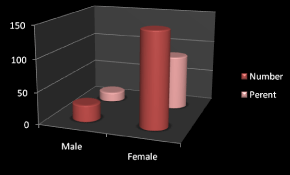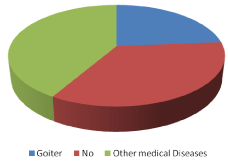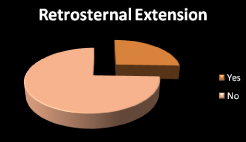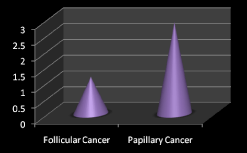Incidence of Recurrent Laryngeal Nerve Following Thyroidectomy without using Intra-Operative Neuromonitoring in Erbil Province - Kurdistan Region - Iraq, A Retrospective Study
Abstract
Introduction: Thyroid gland abnormalities is one of the most common endocrine diseases, thyroid surgery is one of the most common procedures done globally. RLNI is one of disaster complications of total thyroidectomy, carefully dissecting the nerve along its anatomical course, particularly near the thyroid, is the most well-known method of preventing damage to the RLN.
Aim: the aim of current study is to compare the incidence of RLNI in our city with global studies and comparison with its incidence with the use of IONM.
Patients and methods: 173 cases of total thyroidectomies included in this retrospective study which has been done in two hospitals in (Erbil – Iraq) between the period of 18 th December 2013 and 25 th October 2022 without use of IONM.
Results: main indications were pressure symptoms, toxicity, cancer, cosmetic and patient’s wishes, permanent RLNI found in only one case (0.58%), at the time when (0.58% and 1.16%) superior laryngeal nerve injury and transient voice change has been observed.
Conclusion: However RLNI is not completely avoidable but can be minimized to lower rate in the hands of expert surgeons even without using IONM.
Keywords
Total thyroidectomy, Thyroid surgery, RLNI, Nerve injury with thyroidectomy
Introduction
Diabetes mellitus is the most common endocrine illness, followed by thyroid gland abnormalities [1]. Thyroid illness is the most common endocrine disorder worldwide. Medication and surgery are two possible treatment options; thyroid surgery is one of the most common procedures done globally. As of right moment, thyroid surgery is a rather safe treatment. This may be attributed to advancements in anesthesia, improved surgical instruments, increased surgical procedures and antisepsis, and a deeper comprehension of the anatomy and physiology of the thyroid gland. However, like with other surgical operations, postoperative complications are possible after thyroidectomy [2].
Although classic open thyroidectomies (COT) are the main surgical treatment for thyroid cancer, they can leave a prominent, permanent scar in the front of the neck. Surgery is becoming more and more necessary for young women with thyroid cancer. In addition to the procedure's safety, some patients are concerned about the post-operative cosmetic results.
Recurrent laryngeal nerve injury (RLNI), which can lead to postoperative vocal cord palsy (VCP), is a common adverse effect after thyroidectomy. Following thyroid surgery, the recurrent laryngeal nerve (RLN) can be visually detected on a regular basis to reduce the incidence of RLNI [3,4]. The incidence of VCP after thyroid surgery is between 4-8% overall and 1-2% permanently, per published study [5]. Moreover, RLNI can be identified and its risk reduced by intraoperative neuromonitoring (IONM) [6]. This neuromonitoring method can be used intermittently by ipsilateral stimulation of the RLN with a portable monopolar or bipolar probe, or constantly by ipsilateral stimulation of the vagal nerve with clip electrodes applied to the vagus nerve [7,8].
Currently, 93% to 98% of head, neck, and endocrine surgeons in the US and Europe regularly employ either form of IONM to confirm the location of the RLN during surgery [9]. Despite a recent trend toward robust IONM employment to detect and establish the integrity of the RLNs, over 80.0% of European facilities continue to use intermittent IONM. Continuous IONM has been somewhat adopted [9]. Even while intermittent neuromonitoring has a high sensitivity for accurately assessing nerve function, its primary limitations are that it is only useful after RLNI has occurred and is not particularly good at identifying possible injuries [7].
Carefully dissecting the nerve along its anatomical course, particularly near the thyroid, is the most well-known method of preventing damage to the RLN. A number of technical developments, including instrument-based sealing hemostasis and intraoperative nerve monitoring (IONM), were intended to assist surgeons in reducing the occurrence of RLNI. Since inadequate hemostasis is known to raise the risk of RLNI, meticulous hemostasis can be accomplished with a harmonic sealing tool without extending operation time [10]. When IONM is used in cases of complete thyroidectomy, a shorter operating time and a lower incidence of RLNI are also anticipated. But the majority of research has not shown a statistically significant difference [11].
Aim
Finding the incidence of RLNI among patients who have had a total thyroidectomy without the use of IONM in Erbil City in Kurdistan region of Iraq, as well as the risk factors and correlation with this complication, are the goals of this new study.
Patients and Methods
173 cases of Thyroid operations included in this study all cases underwent total thyroidectomies which has been done in Rizgary teaching hospital and Paky private hospital (Erbil – Iraq) between the period of 18 th December 2013 and 25 th October 2022, indications were toxicity, pressure symptoms (dyspnea and dysphagia), suspicion for thyroid malignancies, proved thyroid gland cancer, patient’s wishes and cosmetic background, the cases retrospectively collected, in spite of general pre-operative investigations as CBC, BG and Rh , RFT, RBS, ECG….etc, specific pre-operative investigations also done for all patients such as serum calcium level (as base line for excluding post-operative hypoparathyroidism), Chest X-Ray (for excluding retrosternal extension of goiter) and ENT consultation (for excluding vocal cord paralysis and RLN involvement and as medicolegal point as well) , those patients with pre-operative vocal cord involvement excluded from the study, operations done for one thyroid gland lobe also excluded from the study, all patients underwent direct laryngoscopic inspection by the anesthetist at the end of the operation with the extubation of the endotracheal tube for the states of the vocal cords which are recorded in the files, at the end of the operations one redivac drain put and left for few days, the file revised for surgical complications of gland surgery such as stich granulaoma, hypertrophic and keloid scars, subcutaneous hematoma, tension hematoma, tracheal injury, RLNI, superior laryngeal nerve injury, ….etc., pre-operative data (patients characteristics and demographic data), intra-operative data (operation type, RLN visualization, and nerve injury), and post-operative result (temporary versus permanent nerve injury, histopathology, and post operative treatment and follow up were recorded in the patients files and data entry done in an excel sheet, all the operations has been done by one general surgeon who was PhD certified.
Neuromonitoring was not routinely used because of its unavailability in the centers where operations has been done, most of the cases who underwent thyroidectomy were primary goiter meanwhile some others were fore recurrent goiter, all patients prepared for elective operations, any suspicious case of RLN injury (transient or permanent) referred for ENT specialist for confirmation or exclusion, only total thyroidectomy cases included in the study while other opertaions (near total thyroidectomy, subtotal thyroidectomy and lobectomies) excluded from the study. Follow up of the patients done after five days for stich removal one week after the operations (non-malignant thyroids) they put on 50 mcg levo-thyroxin oral tablet, those with malignant goiters not put on thyroxin replacement and sent for radioactive iodine therapy, then 1-2 months later they put on required dose of thyroxin based on the thyroid function test (TFT) and clinical features of hypo or hyperthyroidism at the surgical outpatient clinic, then followed up for controlling hypothyroidism every six months up to three years and then follow up on annual base, complications such as hypocalcemia dealt with by standard doses of calcium carbonate tablets and calcium gluconate injections, hypoparathyroidism treated with hormone replacement, skin complications such as stich granulaoma, hypertrophic scars and keloid scars sent for dermatological consultations, subcutaneous hematoma and wound infections were conservatively treated.
Statistical analysis for minimum, maximum and mean ages with standard deviation, in addition to pie charts, graph charts and tables calculated by the use of Microsoft excel program version 2010.
Results
173 cases included in this retrospective study, The age of the patients ranged between 9-71 years old with a mean 37.59 and standard deviation 11.92, 147 (84.97%) were female and the remaining 26 (15.03%) cases were male Figure 1 with F:M ration 5.65:1.
41 (23.7%) cases were had positive family history for goiter, 60 (34.68%) cases had no family history of any chronic diseases, meanwhile the remaining 36 (20.81%) cases had family history of other diseases such as hypertension, DM, Ischemic heart disease, gastric cancer….etc. (Figure 2).
Operation were mainly done based on toxicity indication which made up 36.42% (63 no), followed by 27.17% (47 no) for pressure symptoms, and the rest ranged from patient wishes, increase in nodule size, cancer suspicion, cosmetic reasons and proved malignancy (10.98%, 9.83%, 5.78%, 5.78%, and 4.04%) respectively (Table 1 and Figure 3).
Among 47 cases that underwent operation based on pressure symptoms, only 12 of them had retrosternal extension and among toxicity indications only 9 (14.29%) cases diagnoses as Graves ’ disease and the rest were non graves thyrotoxicosis, Figure 4 and Figure 5 respectively.
The number of proved malignant cases were 7, among these 5 (71.43%) cases were papillary thyroid cancer and the remaining 2 (28.57%) cases were follicular thyroid cancer, meanwhile among all 173 cases papillary thyroid cancer made up about (2.89%) of operation indications at the time follicular cancer made up about (1.16%) of the indications, Figure 6 and Figure 7 respectively.
Along the period of follow up, no any complications apart from hypothyroidism observed in more than three quarters of the cases, the commonest complication that has been observed was subcutaneous hematoma (5.78%), followed by transient hypocalcemia and hypertrophic scar in the same frequencies (4.62%), meanwhile permanent RLNI, injury to external laryngeal nerve injury and hypoparathyroidism observed in minimum range within the complications (0.58%), Table 2.
Discussion
1.1% of patients had persistent postoperative vocal cord paresis, according to a retrospective research evaluating the frequency and progression of postoperative RLN damage following thyroid surgery. These findings demonstrate that following a complete thyroidectomy, permanent RLN damage is uncommon.In keeping with previously reported findings, 14% of patients in this retrospective research experienced RLN damage following thyroid surgery [12]. Because bilateral neck exploration is more frequently done during total thyroidectomies, which puts two RLN at risk, this procedure carries a higher risk than lobectomy, subtotal, or near total thyroidectomy. Furthermore, the preparation and dissection methods used for near total, subtotal, and lobectomy thyroid surgeries differ from those used for total thyroidectomy. This may also help to explain why injuries following less extensive thyroid surgeries are less common. However injury to external branch of superior laryngeal nerve is not the subject of our study but it was observer in only one case, this number was the same number of permanent RLNI (0.58%) which is not only in line with the above mentioned studies but it is less in comparison to them, Table 2, The severity of the injury has led to the description of several different therapies [13]. The first steps are typically voice exercises or speech therapy. Vocal cord surgery, such as arytenoid cartilage excision or temporary or permanent vocal cord medialization, may be an option in cases of irreversible damage. Speech treatment was recommended for three, six, or twelve months when a symptomatic one-sided RLN damage manifested. However for the case that observed in our study a part from ENT consultation no further treatment and interventions was applicable in our locality at that time and the patient accepted the voice change permanently, it was also observed that our complication was happened on the papillary thyroid cancer case.
Prior thyroid surgery is among main risk factors were linked to permanent RLN injury [14] in contrast to this study our recurrent goitre operations (1 case) passed smooth post-operative period without any complications and the only RLNI observed in our study was primary operation for papillary thyroid cancer and not recurrent goitre, we can explain this by previous operation of those cases with lobectomies and not total thyroidectomies hence the fields of our operations were not so difficult or adhesive and we could identify the nerve and avoiding their injuries, however the mentioned case was within those cases who developed mild subcutaneous hematoma and treated conservatively.
Although there is conflicting evidence in the literature, several studies have demonstrated that neuromonitoring did not reduce the incidence of RLN injuries [15]. In a study conducted in Istanbul, Turkey [16], both IONM and harmonic sealing equipment were employed in every instance. Following visual identification and bilateral RLN electrical stimulation, a conventional total thyroidectomy was carried out. Although the frequency of RLNI was 4.6%, only 2.3% of individuals experienced permanent RLNI, The vast majority of the cause of adhesion described in the mentioned study had either benign thyroiditis causing adhesion to the surrounding tissues (34%) or papillary cancer (58%), if we compare our study we will observe that the only RLNI case was in papillary thyroid cancer case, neither thyroiditis nor history of previous operation for goiter were the cause of the nerve injury, in the other hand, in spite of not using IONM in any of our operations, only meticulous dissection and precise procedure were the cause of avoidance of nerve injury, this result is in line of the previously mentioned study [15].
There are two types of injuries: temporary and permanent. A temporary injury is one that heals completely in four to six weeks or, in rare cases, up to a year. If not, dysfunctions or non-functions that persist for more than a year are regarded as permanent [3]. However we faced temporary nerve injury in two cases (1.16% complication rate) that lasted for only few weeks and one case (0.58%) of external branch of superior laryngeal nerve injury (in all 3 cases retrosternal extension and pressure symptoms were the indications of operation) in addition to one permanent RLNI mentioned in our study, Table 2. The likelihood of RLN injury is said to be influenced by a number of factors, including the extension of surgery, the kind of pathology (such as malignancy and Graves' disease), gland volume, retrosternal extension, neck dissection, recurrent surgeries and inexperience of the surgeons [3,17,18], all mentioned risk factors were available in our study except the last one, the experience of the surgeon in the thyroid field replaced all other risk factors, since 7 cases in our study had cancer, 9 cases had Graves’ disease, 12 cases had retrosternal extension of goitre as indications for operation Table 1, and Figures (5-8), in addition to a case of recurrent goitre, no serious complications observed apart from only one RLNI that happened on the papillary thyroid cancer cases, so again meticulous dissection and careful working in the field of the gland is the main reason behind this good result.
In a study found that the incidence of transient injuries ranged from 1-30%, while that of permanent injuries ranged from 0.5-5% [3]. Our result was much more better than this mentioned study, since only (1.16%) transient and (0.58%) permanent RLNI found in our study Table 2, our opinion behind this result discussed previously. In another study permanent RLNI has been reported to be substantially lower (0-3.5%), the reported incidence of temporary RLNI ranges from 0 to 12% [19], again if we take the average of these two mentioned ranges, our result for both transient and permanent nerve injuries are within normal range and may be better as well.
Total thyroidectomy has been shown to carry a higher risk of nerve damage than other conservative procedures [20]. however apart from one permanent RLNI, two transient voice change and one injury to the external branch of superior laryngeal nerve no further nerve injuries found in our study in which all cases underwent total thyroidectomy in addition to that point other conservative procedures such as lobectomy, subtotal thyroidectomy and near total thyroidectomy excluded from the study, so comparison between total and conservative thyroidectomy was not the aim of our study.
While it is impossible to completely prevent RLN injury, the risk should be considerably decreased by careful intraoperative examination and knowledge of its anatomical course and changes [3]. In terms of anatomy, the right RLN has a variable course in the neck, while the left RLN has a simple trajectory. Compared to the left RLN, the right RLN is somewhat more lateral. Understanding the various correlations between the RLN and the inferior thyroid artery is also crucial. The question of whether recurrent nerve dissection raises the likelihood of RLN injury is still up for debate. According to a number of studies, recurrent nerve dissection is helpful in complex situations like thyroid cancer but is not required in partial thyroidectomy [20] same rules and principles applied for identification of the nerve in difficult and adhesive cases and the same result we got that’s why 100% avoidance of the nerve injury was impossible and (0.58%) nerve injury complication observed and in contrast to mentioned course of the nerves our complication was on the left RLN, this can be explained by severe adhesion of the cancer tissues that made difficulties in the surgery and failure of avoiding the nerve injury.
Fortunately we did not faced bilateral RLNI in our study but aspiration and respiratory distress can occur quickly in cases of bilateral RLNI and can be fatal. Thus, it is imperative that all preventative measures, such as careful observation and tracheostomy, be implemented very away. The most well-known method for preventing damage to the RLN is to carefully dissect the nerve throughout its entire anatomical route [21,22]. That’s why all standard and well known rules followed in our operations to prevent nerve injuries. However we did not used IONM in any operation for our study because of lack of the device in our locality at that time, Surgeons have been using IONM in greater proportions even though there is no proof that it is superior to the conventional anatomic dissection of RLN [11]. So this will be in concordance to our result in which without IONM very good result has been achieved in regards to nerve injury incidence in our study. whatever the cause of not using IONM, but there is no doubt about that IONM was created to monitor the nerve in order to prevent needless dissection because functional damage of the RLN is not obvious macroscopically [21,22].
Since inadequate hemostasis is known to raise the risk of RLNI, meticulous hemostasis can be accomplished with a harmonic sealing tool [10]. In spite of the mentioned advantages of harmonic device but we did not used it, alternatively we used ligatures and bipolar diathermy for removing the gland and for hemostasis as well, and the result of our study was satisfying in the term of nerve injuries, however in regards to subcutaneous hematoma that observed in about (5.78%) of the cases (Table 2) may be due to mentioned cause.
Conclusion
Careful and meticulous dissection of thyroid gland is very crucial for difficult and adhesive thyroidectomies such as cancer, thyroiditis, redo operations and retrosternal extensions of the goiter. Careful and meticulous dissection has minimum risk of RLNI during total thyroidectomy even without the use of IONM especially in the hands of experienced surgeons.
Recommendation
Instead of depending on IONM, good surgical skills, training and experience in the field of thyroid gland must be more taken in consideration.
Source of Funding
This research received no specific grant from any funding agency in the public, commercial, or not-for-profit sectors.
Conflict of Interest
The authors declare that they have no competing interests.
Ethical Approval
This study was approved by the Scientific Research Ethics Committee of the Faculty of General Medicine, Koya University, Koya, Erbil, Kurdistan Region, Iraq
References
- Biondi B, Kahaly GJ, Robertson RP (2019) Thyroid dysfunction and diabetes mellitus: Two closely associated disorders. Endocr Rev 40: 789-824.
- Karamanakos SN, Markou KB, Panagopoulos K, et al. (2010) Complications and risk factors related to the extent of surgery in thyroidectomy: Results from 2,043 procedures. Hormones 9: 318-325.
- Joliat GR, Guarnero V, Demartines N, et al. (2017) Recurrent laryngeal nerve injury after thyroid and parathyroid surgery: Incidence and postoperative evolution assessment. Medicine 96: e6674.
- Zakaria HM, Al Awad NA, Al Kreedes AS, et al. (2011) Recurrent laryngeal nerve injury in thyroid surgery. Oman Med J 26: 34-38.
- Liu N, Chen B, Li L, et al. (2021) Recurrent laryngeal nerve injury near the nerve entry point in total endoscopic thyroidectomy: A retrospective cohort study. Cancer Manag Res 13: 8979-8987.
- Davey MG, Cleere EF, Lowery AJ, et al. (2022) Intraoperative recurrent laryngeal nerve monitoring versus visualisation alone-A systematic review and meta-analysis of randomized controlled trials. Am J Surg 224: 836-841.
- Schneider R, Machens A, Sekulla C, et al. (2021) Superiority of continuous over intermittent intraoperative nerve monitoring in preventing vocal cord palsy. Br J Surg 108: 566-573.
- Staubitz JI, Musholt TJ (2021) Continuous intraoperative recurrent laryngeal nerve monitoring: Techniques, applications, and controversies. Current Otorhinolaryngology Reports 9: 326-333.
- Bartsch DK, Dotzenrath C, Vorländer C, et al. (2019) Current practice of surgery for benign goiter-An analysis of the prospective DGAV StuDoQ|Thyroid Registry. J Clin Med8: 477.
- Hammad AY, Deniwar A, Al-Qurayshi Z, et al. (2016) A prospective study comparing the efficacy and surgical outcomes of harmonic focus scalpel versus Ligasure small jaw in thyroid and parathyroid surgery. Surg Inno 23: 486-489.
- Khamsy L, Constanthin PE, Sadowski SM, et al. (2015) Loss of neuromonitoring signal during bilateral thyroidectomy: No systematic change in operative strategy according to a survey of the French Association of Endocrine Surgeons (AFCE). BMC Surg 15: 95.
- Christou N, Mathonnet M (2013) Complications after total thyroidectomy. J Visc Surg 150: 249-256.
- Hayward NJ, Grodski S, Yeung M, et al. (2013) Recurrent laryngeal nerve injury in thyroid surgery: A review. ANZ J Surg 83: 15-21.
- Wang CC, Chang MH, De Virgilio A, et al. (2015) Laryngeal electromyography and prognosis of unilateral vocal fold paralysis--A long-term prospective study. Laryngoscope 125: 898-903.
- Malik R, Linos D (2016) Intraoperative neuromonitoring in thyroid surgery: A systematic review. World J Surg 40: 2051-2058.
- Yuksekdag S, Topcu A, Deveci I, et al. (2019). Recurrent laryngeal nerve injury in total thyroidectomy with intraoperative nerve monitoring and harmonic sealing instrument: A retrospective analysis and treatment results. East J Med 24: 210-214.
- Cannizzaro MA, Lo Bianco S, Picardo MC, et al. (2017) How to avoid and to manage post-operative complications in thyroid surgery. Updates Surg 69: 211-215.
- Godballe C, Madsen AR, Sørensen CH, et al. (2014) Risk factors for recurrent nerve palsy after thyroid surgery: A national study of patients treated at Danish departments of ENT Head and Neck Surgery. Eur Arch Otorhinolaryngol 271: 2267-2276.
- Pantvaidya G, Mishra A, Deshmukh A, et al. (2018) Does the recurrent laryngeal nerve recover function after initial dysfunction in patients undergoing thyroidectomy? Laryngoscope Investig Otolaryngol 3: 249-252.
- Bawa D, Alghamdi A, Albishi H, et al. (2021) Post-thyroidectomy complications in southwestern Saudi Arabia: A retrospective study of a 6-year period. Ann Saudi Med 41: 369-375.
- Cavicchi O, Burgio L, Cioccoloni E, et al. (2018) Intraoperative intermittent neuromonitoring of inferior laryngeal nerve and staged thyroidectomy: Our experience. Endocrine 62: 560-565.
- Bai B, Chen W (2018) Protective effects of intraoperative nerve monitoring (IONM) for recurrent laryngeal nerve injury in thyroidectomy: Meta-analysis. Sci Rep 8: 7761.
Corresponding Author
Senk Nawzad Barzinjy, Medical Student, Kirkuk Medical College, Kirkuk, Kurdistan Region, Iraq.
Copyright
© 2025 Abdullah SF. This is an open-access article distributed under the terms of the Creative Commons Attribution License, which permits unrestricted use, distribution, and reproduction in any medium, provided the original author and source are credited.











